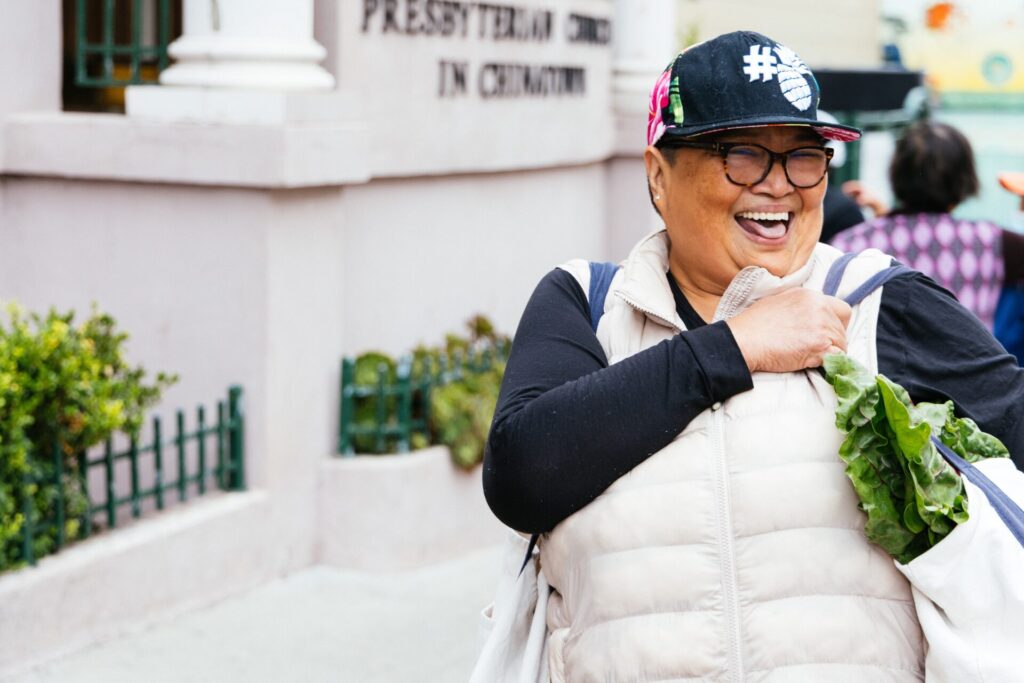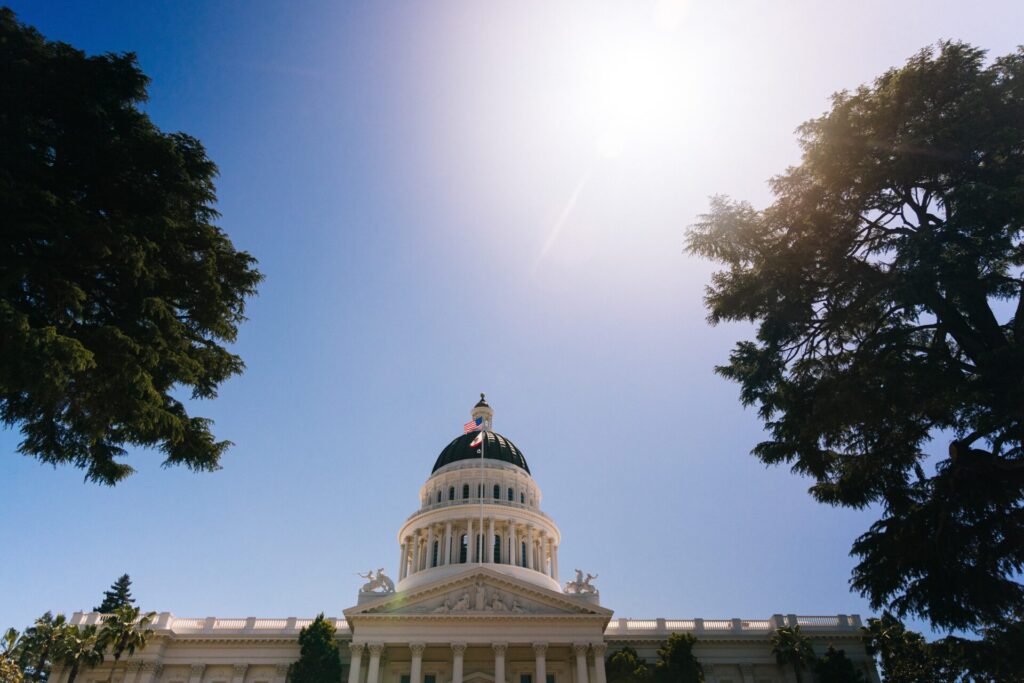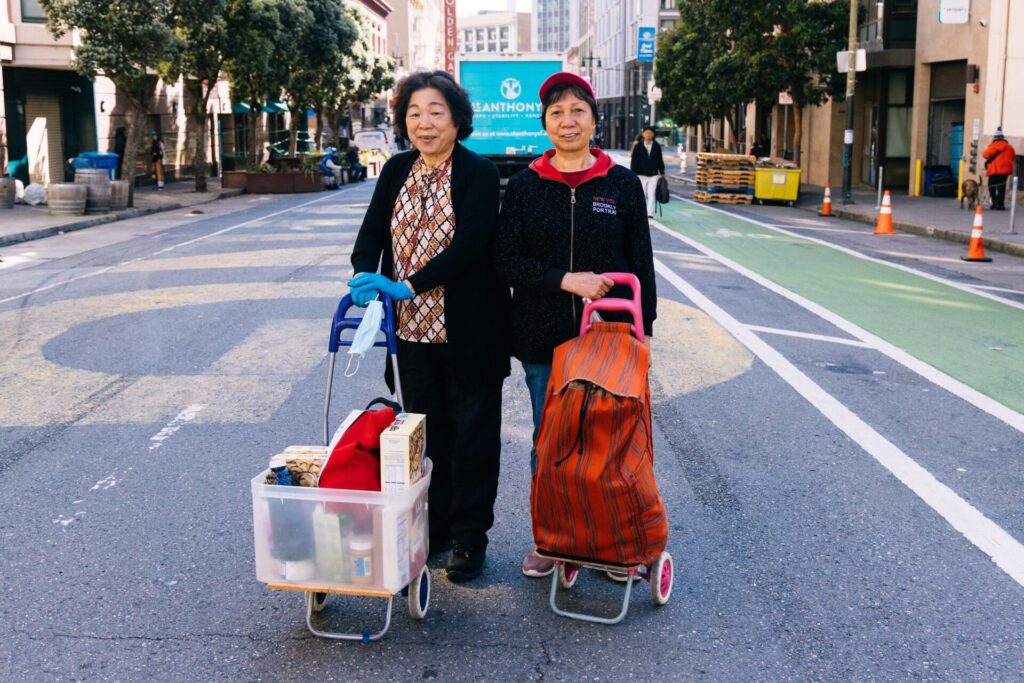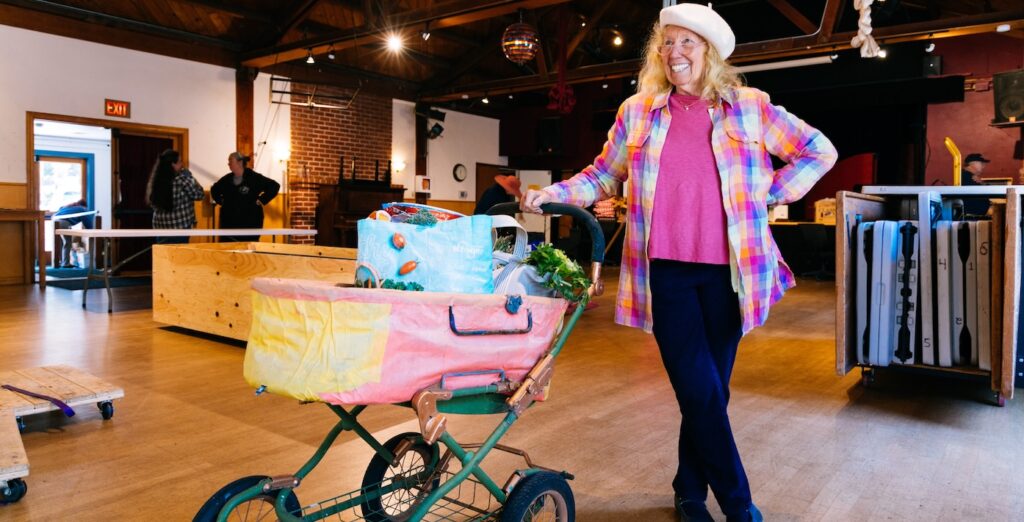 Alma loves to cook for her husband, her daughters, and her neighbors. Sisig sizzling in the pan. Chicken congee, fragrant with fried garlic and spring onion. Tilapia steamed with tomatoes and garlic.
Alma loves to cook for her husband, her daughters, and her neighbors. Sisig sizzling in the pan. Chicken congee, fragrant with fried garlic and spring onion. Tilapia steamed with tomatoes and garlic.
“Sometimes I share with the manager of my apartment,” she laughs. “He said he likes [my cooking].”
These days, making those meals takes more than culinary skills. It takes support.
Alma retired to care for her husband, who’s on dialysis. Living on a limited income, she depends on the food pantry at Presbyterian Church in Chinatown (PCC), part of the San Francisco-Marin Food Bank’s Neighborhood Food Network, for the nutritious food her husband needs to stay healthy.
“This pantry is a very big help,” she says. “Food is so expensive now.”
Alma is one of what will eventually be 350 neighbors served by this pantry at PCC. Her story shows exactly why opening it mattered so much, at a moment when hunger was deepening and help was disappearing.
Neighbors Refuse to Let Neighbors Go Hungry
 During the COVID-19 pandemic, the Food Bank launched Pop-Up Pantries across San Francisco and Marin in response to surging food insecurity. Alma went to the Stonestown Pop-Up during this time, grateful for a reliable food source while she was working but still struggling to make ends meet.
During the COVID-19 pandemic, the Food Bank launched Pop-Up Pantries across San Francisco and Marin in response to surging food insecurity. Alma went to the Stonestown Pop-Up during this time, grateful for a reliable food source while she was working but still struggling to make ends meet.
But due to funding cuts, all Pop-Up Pantries closed last summer. Alma didn’t have anywhere to go. Volunteers lost their connection to community. Thousands of people in San Francisco and Marin lost their regular source of food.
The Food Bank worked to expand capacity across its partner network and transfer as many participants as possible to neighborhood food pantries.
Susie Wong, volunteer pantry supervisor, was already running two PCC food pantries: a Saturday senior pantry and a Thursday distribution at Cameron House. So, when Lesley Kraechan, an energetic, cheerful Lions Club volunteer from the North Beach Pop-Up, approached Susie about opening a third pantry, she thought they’d be stretched too thin. Then she realized the Pop-Up Pantry volunteers were eager to help.
“These North Beach and Bessie Carmichael volunteers still wanted to work,” Susie recalled. “[Lesley and I] had like 50 people sign up, saying, ‘Please let me, I wanna help.'”
Together, these volunteers opened the pantry less than two months after the Pop-Ups closed. Alma came to PCC to ask if she could get on the waitlist. Now, she’s grateful to pick up groceries even closer to home.
Roots in the Community
 Susie has deep connections to Chinatown, which is why she still volunteers here despite living in the East Bay. She worked at Chinatown Community Development Center for 19 years building affordable housing. “I saw that these folks really lived with very little income,” she recalls. “A lot of them worked in the United States for decades, but they never got their Social Security because of under the table pay. They’re hardworking, but they’re struggling.”
Susie has deep connections to Chinatown, which is why she still volunteers here despite living in the East Bay. She worked at Chinatown Community Development Center for 19 years building affordable housing. “I saw that these folks really lived with very little income,” she recalls. “A lot of them worked in the United States for decades, but they never got their Social Security because of under the table pay. They’re hardworking, but they’re struggling.”
Like Susie, Lesley’s commitment to the pantry is rooted in her work serving the community. A physical therapist and member of PCC, Lesley started volunteering with the Food Bank during the pandemic. She works with women survivors of violence with chronic conditions and sees firsthand how poor nutrition contributes to their pain and illness. Leslie says she’s grateful that she can support the Food Bank’s mission to provide the fresh fruits, vegetables, and other nutritious food that can improve health and wellness. “If we can get healthy food to people, we can have a society of people that are healthier, happier, better,” she says.
Nothing Goes to Waste
With her fresh produce in hand from the pantry, Alma is already thinking about what she’ll cook next.
“With what I get here, I can keep cooking for my family and not worry about wasting anything,” she says.
For Alma, cooking is how she shows she cares. And with volunteers like Susie and Lesley stepping up alongside the Food Bank, this pantry ensures she’ll have the fresh, healthy food she needs to keep cooking for her family. For Alma, that’s where joy is: in the cooking, and in sharing what she makes.


 Sunlight streams through the floor-to-ceiling windows of the Western Addition Community Market. The space is modern and welcoming, with the cheerful energy of a neighborhood bodega — energy matched by Holly. We met her as she moved excitedly through the aisles of produce and groceries, planning out what she would take home.
Sunlight streams through the floor-to-ceiling windows of the Western Addition Community Market. The space is modern and welcoming, with the cheerful energy of a neighborhood bodega — energy matched by Holly. We met her as she moved excitedly through the aisles of produce and groceries, planning out what she would take home. Even when you’re mission-driven, it can take a few turns to find someplace where your work truly reflects your values and you can see its impact every day.
Even when you’re mission-driven, it can take a few turns to find someplace where your work truly reflects your values and you can see its impact every day. When Jeni decided to donate her late husband’s red Ford Ranger to the San Francisco-Marin Food Bank, it wasn’t just about parting with a vehicle. It was about honoring his life in the community he cared about.
When Jeni decided to donate her late husband’s red Ford Ranger to the San Francisco-Marin Food Bank, it wasn’t just about parting with a vehicle. It was about honoring his life in the community he cared about.
 For Veronica, finding help has often meant navigating a maze of complicated systems without much support to guide her through.
For Veronica, finding help has often meant navigating a maze of complicated systems without much support to guide her through. Where Food and Connection Meet
Where Food and Connection Meet At the Food Bank, we believe food is a human right. Recent policy wins at the state level are helping move us closer to a future where everyone in California can count on consistent access to healthy food and a stronger safety net.
At the Food Bank, we believe food is a human right. Recent policy wins at the state level are helping move us closer to a future where everyone in California can count on consistent access to healthy food and a stronger safety net.
 A New Home on the Greenway
A New Home on the Greenway Earlier this year, John moved from Kenya to San Francisco to be closer to his daughter and her two children after his wife passed away. John now lives in the bustling Western Addition neighborhood, navigating a new country, a new community, and a new way of life.
Earlier this year, John moved from Kenya to San Francisco to be closer to his daughter and her two children after his wife passed away. John now lives in the bustling Western Addition neighborhood, navigating a new country, a new community, and a new way of life.
 When people think about seaside towns in Marin County, they often conjure up visions of luxury. But nestled just below the Point Reyes National Seashore is the tight-knit town of Bolinas, where the reality is quite different.
When people think about seaside towns in Marin County, they often conjure up visions of luxury. But nestled just below the Point Reyes National Seashore is the tight-knit town of Bolinas, where the reality is quite different. The steady supply of food is what makes the 13-year partnership between the Bolinas Community Inc. food pantry and the San Francisco-Marin Food Bank essential. More than 200 people come through the pantry each Thursday, relying on the shelf-stable staples and fresh produce. And for many, the chance to connect is just as much of a lifeline.
The steady supply of food is what makes the 13-year partnership between the Bolinas Community Inc. food pantry and the San Francisco-Marin Food Bank essential. More than 200 people come through the pantry each Thursday, relying on the shelf-stable staples and fresh produce. And for many, the chance to connect is just as much of a lifeline. For Alfonz, a longtime participant managing serious health conditions, the pantry is essential to his stability. “I used to go in every day to the emergency room because something went wrong every day,” he recalls. But now that he’s able to eat the healthy food he needs to manage his symptoms, his quality of life has improved.
For Alfonz, a longtime participant managing serious health conditions, the pantry is essential to his stability. “I used to go in every day to the emergency room because something went wrong every day,” he recalls. But now that he’s able to eat the healthy food he needs to manage his symptoms, his quality of life has improved.
Share